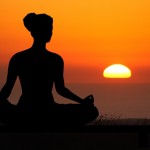Body Meditation

Buddha directed people to contemplating the body frequently, and for good reasons. Meditating on the body:
- Helps get you out of your head
- Reminds us of our physical nature and characteristics
- Provides several points to settle busy minds
- Shows us the direct experience of impermanence and not self
For the next couple of weeks, do this body meditation for at least 10 minutes each day, or at when you can. Over time, you’ll observe interesting changes. This body meditation also helps with concentration, and is good for especially restless minds. Sometimes I do this body meditation before settling on the breath for the rest of the meditation.
Body Mediation Steps
- Sit on a chair or a meditation cushion so you are comfortable
- Shake out your hands and arms, then rest them comfortably on your lap or thighs
- Close your eyes and take a few deep breaths, inhaling slowing and exhaling slowly
- With eyes closed, bring your mental attention to the top of your head. Can you feel any sensations? Many parts of the body may be imperceptible.
- Keep your attention on the top of your head. If your attention veers, or you are interrupted with a thought, let go of the thought, and move your attention down your ears.
- Focus your attention on your ears. Keep your attention there, mentally observing or being present with your ears. When your attention veers again, move your attention to your face.
- Keep your attention on your face. You can focus on your whole face, or start at your forehead and stay there, only moving down as your attention drifts, or thoughts interrupt you.
- Next move your attention to your neck, then shoulders, then chest, then back, moving downward only as your attention is pulled away by interrupting thoughts, emotions, sounds, etc.
Throughout the rest of this meditation, you will keep your attention on a certain part of the body, stay focused there as long as you can. As soon as something arises to interrupt your concentration on that part of the body, such as a thought, sensation, sound, etc., move down to the next part of the body. Continue this body mention all the way to your feet, and then back up again. Don’t worry about the order of body parts where you direct your attention. Just stay with each part as long as you can before letting go of what interrupts you and moving to the next.
This meditation can take a long time if your concentration lasts a long time in each area. If your mind is busy and continuously interrupts you, then you move through this meditation more quickly. If you practice this meditation daily, you may experience an increase in concentration, and some days you may only have time to focus on a few body parts. Other days you’ll notice you went through a whole body scan because thoughts kept interrupting you. As with meditations on the breath, the idea is to always let go of whatever interrupts. Letting go gets a good workout while concentration increases.
Another variation of this meditation I enjoy is focusing only on body parts where I have strong sensation such as pressure, warmth, pain, etc. I start at whatever sensation is strongest in my head, then move down to the pressure points of my arms against my sides, then to the warmth of my hands on my thighs, etc.
You can also do a version of body meditation while out and about. If I’m standing in line at the grocery store, I focus my attention on the sensation of my feet pressing into the floor, any breezes that whisk past, the cool feel of the handle of the shopping cart, the feeling of my breath going in and out. Of course, while in public I keep my eyes open!
This is not about zoning out. Body meditation helps us to learn to let go of whatever arises in the mind, helps keep us in contact with an ever-changing body, the fact that our bodies are impermanent, and these changing bodies are not self. Additionally, body meditation helps keep us grounded, out of the drama and stories of our minds, and helps us to train us to only follow skillful thoughts while being mindful of where we are in our environment and how we interact with the world.
See Also:
